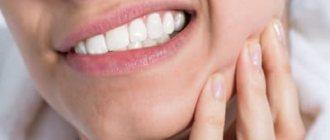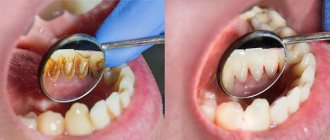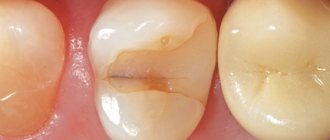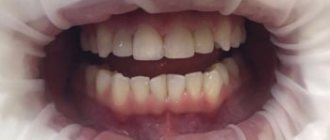31.10.2019
A trip to the dentist does not always end the way you would like. A common situation is when a tooth reacts to exposure to cold after a filling procedure. The reaction of a tooth to cold is a complication that results from the installation of a filling. This material will tell you why this situation occurs and how you can deal with it.
Causes of hypersensitivity
After treatment does the tooth react to cold?
The increased reaction of the tooth to exposure to low temperatures indicates only one thing - the dental nerve is alive, and its reaction is hypersensitive.
This occurs under certain circumstances listed below.
If you have illnesses:
- Pulpitis is an inflammation of the neurovascular bundle. Here the pain is prolonged and can last from a couple of hours to several days.
- Caries is the destruction of hard tooth tissues. In this case, the pain will occur for a short period of time and gradually fade away.
The dentist will carry out the process of installing a filling only after he has eliminated the true cause of the tooth disease.
Installing a filling after caries treatment as a problem of discomfort
Caries has two degrees of progression: chronic and acute. There are also several forms of dental damage by this pathology: deep, medium and initial.
The dentist treats deep and medium forms of lesions by mechanical treatment of the affected area, followed by installation of a filling.
If during the treatment of the tooth part of the tissue affected by caries was left behind, this may become the root cause of pain when exposed to cold.
In some dental offices, doctors use a special liquid that stains the affected part of the dental tissue with a certain color. This is very convenient, since the dentist can clearly see which area needs to be removed. But not all doctors use this drug.
In a filled tooth, pain can also be caused by other reasons, for example, improper filling procedures for deep caries. The chronic course of caries will be expressed by dense pigmented dentin, in which case the procedure for removing the affected tissue can be stopped, followed by the installation of a filling.
If the dentin is soft, the dentist may decide to strengthen it with a lining containing calcium. In this case, it does not open the tooth cavity. The infection contained in the affected bottom of the cavity gradually penetrates into the dental cavity through the dentinal canals.
Inflammation of the neurovascular bundle, accompanied by pain, is a response to infection.
The occurrence of pulpitis can be provoked by incorrect tactics of the procedure, when in the process of removing tissues affected by caries, sufficient air-water cooling of the tooth tissues was not applied. The consequence of this is heating of the pulp tissue, which provokes the occurrence and development of pulpitis.
Pulpitis as a source of discomfort
Pulpitis is an inflammation of the neurovascular bundles inside the tooth, that is, the pulp. The cause is infection or constant inflammatory process. It can also develop against the background of overheating or overvoltage. Read more about how to identify pulpitis here.
When treating this problem in children, it is carried out by amputation of the coronal part of the pulp, with further filling. If a child complains of pain after therapy, the procedure may be performed incorrectly. With pulpitis, cold food causes severe discomfort. A characteristic symptom of acute serous focal pulpitis is night pain of a pulsating type.
Treatment of pulpitis is carried out in several stages. After preparation, the tooth is closed with a temporary filling until the next visit to the doctor. If a patient misses a visit to the dentist and a permanent filling, tooth sensitivity occurs.
Pulpitis as a cause of pain after filling
With this pathology, inflammation of the nerves and blood vessels that are located in the dental tissue occurs.
Its occurrence can be provoked by nervous strain, infection and overheating of the pulp tissue.
Painful sensations after filling again indicate that the procedure was performed incorrectly.
Due to frequent night pain, the tooth is amputated, since the infection penetrates from the crown to the root area.
Another cause of pain is incomplete removal of the neurovascular bundle. There is a possibility that not all canals were found and passed through by the dentist.
The process of treating pulpitis most often extends over several visits to the doctor. In this case, the dentist will place a temporary filling from visit to visit until the treatment process is completed and the permanent filling is installed. If the treatment is delayed, after some time microscopic gaps appear between the temporary filling and the dental tissue, through which irritants (including cold ones) penetrate into the dental cavity, causing pain.
Why did the tooth begin to react to cold and hot after filling?
After proper caries treatment, discomfort may be normal. This is a consequence of a “disturbed” tooth. If the discomfort lasts longer than 2–3 days, this is a reason to immediately make a second appointment with the dentist. Only a specialist can correctly diagnose the cause of the complication. Most often, after filling, a tooth reacts to cold and hot food or drinks. In case of severe complications, discomfort is caused not only by ice, but also by simply cool drinks. For more information about why a tooth with a removed nerve reacts to heat, see below.
Causes of increased sensitivity after caries treatment
Main causes of discomfort:
- caries requiring filling (causes necrosis of hard tissues, including under the filling);
- pulpitis (inflammation of the neurovascular bundle);
- hyperesthesia (increased sensitivity of tissues, including those not related to the treatment process);
- secondary caries.
In most cases, secondary caries develops due to unqualified treatment or non-compliance with hygiene standards.
Before treatment for caries, a reaction to sweets and cold is noted. After tooth preparation and filling, a reaction to cold and hot is noted. This is a sign that not all damaged hard tissue was removed before filling. A focus of inflammation remains under the filling, which leads to the development of pulpitis. This occurs especially often at the stage of medium and deep dental caries. Another reason is improper cooling of tooth tissues during preparation of a diseased tooth. Excessive heating of tissues leads to increased sensitivity.
Another reason for discomfort after filling is violation of the dentist’s recommendations. If a temporary filling is placed during the treatment of pulpitis, you should not take breaks in treatment. A seal placed for a short time will depressurize after a while, which leads to increased sensitivity to cold.
If therapy for caries and pulpitis is completed successfully, then hyperesthesia becomes a possible cause of sensitivity to cold. The cause of increased sensitivity is microcracks in the enamel or anatomically determined expansion of the nerve canaliculi. To eliminate it, you can use special pastes. Read more about toothpastes for sensitive teeth in this material.
When pain is normal
There are very frequent cases when the procedure for treating caries and pulpitis is carried out according to all the rules, but pain still occurs.
In this case, the cause of the pain is hyperesthesia.
Excessive sensitivity of dental tissues to various irritants is hyperesthesia.
Symptoms intensify if there are small cracks in the enamel of the teeth. Various factors contribute to the appearance of such cracks:
- Damage to the enamel from mechanical impact (hard bristles of a toothbrush, during the whitening process, due to impact or scratch with cutlery, etc.).
- Exposure of enamel tissue to aggressive nutrients (for example, citric acid).
Diagnosis of pathology
At home, you can check the correct installation of the filling in a simple way - pour cold or hot water into your mouth.
If pain occurs immediately and passes just as quickly, the cleaning procedure for removing tissue affected by caries has not been carried out sufficiently.
Taking into account the fact that not all procedures were performed correctly in the treatment of pulpitis, the pain will gradually increase and just as slowly go away.
In some cases, pulsation appears inside the tooth - this is the result of overheating of the dental tissue during the preparation process.
If symptoms do not go away within a few days, consult a doctor.
Dentists diagnose the cause of pain by examining the oral cavity. The tightness of the seal is examined and exposure to cold air and water is applied. After removing the filling, the doctor performs probing by tapping on the tooth. When painful sensations appear in various areas, the existing pathology is determined.
Pain in the walls is a sign of medium caries, in the bottom of the tooth – its deep form, and deep in the mouth of the canal – pulpitis.
Treatment in dentistry
Few people manage to cope with the problem of increased tooth sensitivity at home. Basically, to solve this problem, sooner or later they turn to professionals, who, in turn, offer radical methods of combating hyperesthesia:
- Fluoridation
(simple or deep). A special fluoride-containing composition is applied to the teeth, which helps strengthen the enamel. Simple fluoridation requires several procedures, while deep fluoridation is performed in one visit to the doctor, and is more effective. - Remineralization
is the treatment of teeth with special compounds that can compensate for the deficiency of minerals in the enamel. - Coating with special dental varnishes
. These preparations seal the surface of the tooth, covering it with a dense film, thereby ensuring the strength of the enamel and preventing its further destruction.
If you suddenly feel that your teeth are reacting to cold or hot, immediately contact an experienced specialist who will carry out all the necessary manipulations to solve your problem:
- Initial examination. Detection of dental diseases (caries, pulpitis, gum disease, etc.).
- Drawing up a clear treatment plan.
- Sanitation of the oral cavity, elimination of all existing foci of infection.
- Removal of plaque and tartar (professional cleaning).
- Treatment of enamel with a selected composition (fluoridation, remineralization, varnishing).
After the procedure, the doctor will recommend using only special pastes, reviewing your diet by adding more foods rich in calcium and fluoride, and, of course, visiting the dentist at least once every 6 months.
Solution
If after the filling procedure pain is diagnosed, then you need to wait 2-3 days, perhaps they will pass.
During this period, it is recommended to take painkillers with anti-inflammatory properties.
The pain does not subside after 72 hours - you should contact your dentist.
At a repeated appointment, the dentist performs the following series of actions for caries:
- Produces local anesthesia.
- Removing the seal.
- Removal of the area affected by caries.
- Reinstallation of the filling.
The stages of treatment of pulpitis (primary or repeated) are as follows:
- Administration of an anesthetic drug.
- Removing the filling and providing access to the tooth canals.
- Treatment of canal-containing areas using dental instruments with parallel exposure to an antiseptic.
- Installing a filling on a dental canal.
- Filling a tooth with a permanent or temporary filling (this is decided by the dentist).
If a doctor has installed a temporary filling for you, this means one thing - you will definitely have to visit him on the appointed day. If this is not done, the consequences may be negative.
Prevention and prevention
In order to prevent pathology from occurring, it is necessary to protect your enamel from various damages. To do this, follow a number of simple rules:
- Visit your dentist at least twice a year for a checkup.
- Balance your diet so that sour and sweet foods are found in minimal quantities.
- Avoid using toothbrushes with hard bristles. They can not only damage gum tissue, but also cause microscopic scratches on the enamel.
- Avoid eating excessively hot foods with cold foods (such as hot coffee and ice cream). Due to sudden temperature changes, tooth enamel can crack.
- Avoid teeth whitening procedures using aggressive chemicals. If you want your teeth to be snow-white, use whitening pastes. The process is longer, but safe for the enamel.
- Maintain personal hygiene: brush your teeth 2 times a day with toothpaste that does not contain aggressive elements.
A very effective prevention would be the use of mouth rinses. They can be produced by pharmaceutical companies and sold in finished form. Or you can make a special decoction at home, based on various herbs and plants.
If you experience pain while brushing your teeth or eating cold food, contact your dentist immediately. Delay will lead to destruction of the integrity of the tooth and nerve endings.
Treatment at home
Unfortunately, getting an appointment with a good dentist can be very difficult. But what to do if you need help in the fight against increased sensitivity of teeth right now? To solve this problem, you can turn to effective folk and home remedies:
- For many years, decoctions (infusions) of herbs have been considered one of the most effective remedies. They relieve inflammation, many of them have antibacterial, soothing and healing properties. You can prepare a decoction of chamomile, oak bark, sage, oregano, calendula, and burdock. You can make an herbal cocktail - mix several dry herbs, pour boiling water and cook in a water bath for 15 minutes, cool and rinse your mouth several times a day.
- Propolis is very famous for its antibacterial properties. You can use it to prepare an alcohol tincture for mouth rinsing by pouring alcohol into a piece of propolis.
- If you are a big fan of warm milk, then the following method is created especially for you - all you need is to simply drink warm milk more often, but do not immediately swallow it, but leave it in your mouth for a while. Why does this method work? Milk contains calcium, which has a beneficial effect on tooth enamel, strengthening it, thereby reducing tooth sensitivity.
However, the surest way to get rid of increased tooth sensitivity is to use special pastes, gels and mouth rinses with fluoride. If you do get an appointment with a dentist, he will most likely suggest that you undergo a fluoridation or teeth remineralization procedure.
You should not rely entirely on folk and home remedies. They may serve as an adjunct to primary therapy rather than as the sole treatment.
Choosing toothpaste
Needless to say, you need to pay special attention to the choice of toothpaste? The first thing you need to learn is that if increased tooth sensitivity occurs, you need to give up whitening pastes (at least for a while, until this problem is finally resolved). Subsequently, such means can be used, but very carefully.
So, what to look for when choosing toothpaste for sensitive teeth:
- Choose only special toothpastes (usually manufacturers indicate this on the packaging);
- Pay attention to special medications that reduce tooth sensitivity (they are sold exclusively in pharmacies);
- It is recommended to give preference to pastes or gels with a high fluoride content - such preparations, if used regularly, restore tooth enamel, thereby coping with the problem of hypersensitivity.
Don’t forget about choosing the right toothbrush - it should be of medium hardness in order to remove food debris from the surface of the teeth without scratching the enamel.










